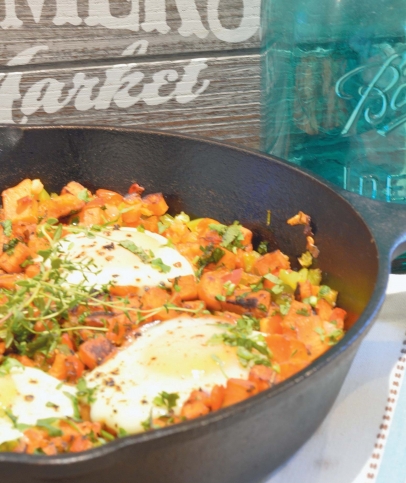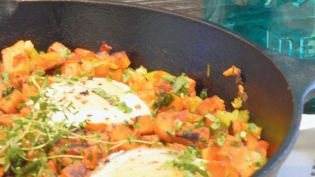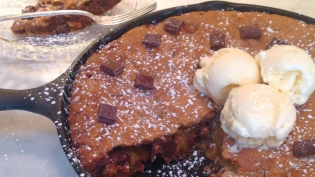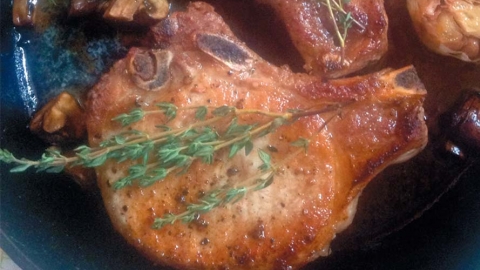Kitchenware that Never Grows Old
BEHIND EVERY CAST IRON SKILLET THERE’S A STORY
Maybe yours was handed down from your mother or grandmother. Or perhaps you picked it up at a garage sale and tucked it in a storage box in the basement only to forget about it. You might have even bought it for that one-time camping trip where you needed something heavy-duty to use on a hot campfire, never thinking about using it indoors.
My story is simple. My first cast iron skillet was a family hand-me-down. I like to think of it as a culinary heirloom. I come from a long line of German home cooks who used their trusty cast iron skillets for everything from puffy German pancakes generously dusted with powdered sugar to succulent pork roast nestled in apples and potatoes.
My cast iron skillet collection expanded when I purchased a restaurant. Four more skillets were added to the family, two that were used only for desserts plus two that we used for blackening steaks and tuna. Cast iron is porous and absorbs flavor, so having a couple designated pans for sweet and savory dishes is advised for true cast iron aficionados. But more about that later.
CAST IRON SKILLET HISTORY
Cast iron skillets may seem old school, but during the last few years, there has been a resurgence of love for these heavy-duty pans. Founded in 1886, Lodge Cast Iron is the lone remaining cast iron producer in the United States. Tucked in the hills of South Pittsburg, Tennessee, the company’s products have enjoyed a comeback in popularity over the past years.
The increase in sales coincided with the company’s 2002 addition of pre-seasoned cast iron pans to the company’s product line. The cast iron pan market had softened, and the company was looking to bring new life to their hallmark product. There was a stigma that cast iron was difficult to use and that there was a complicated seasoning process involved. Today, all of the Lodge Cast Iron pans are pre-seasoned directly in the foundry, making them ready to use right out of the box.
CAST IRON PAN MAINTENANCE
Maintenance is easy but should be done after every use, even if pans are purchased seasoned. One reason folks are so fond of their old cast iron skillets is the shiny patina created on the inside of the pan that builds up with each use. It is this shiny surface that creates a virtually non-stick pan. After each use, wash the pan out with warm water. Because cast iron absorbs flavor, a neutral-flavored oil, like vegetable or grape seed, is recommended for seasoning the pans. Use a paper towel to put a thin layer of the neutral oil over the pan’s cooking surface. The pan can be placed on medium heat for a few minutes to ensure the pan is dry; however, this step is not necessary. The pan is now ready to be put back in action.
CAST IRON PANS CAN ABSORB FLAVORS
Cast iron is naturally porous and can absorb certain food flavors. A pan that is used frequently for savory recipes is not a great choice for bread and dessert recipes.
It’s helpful to have two cast iron pans, one dedicated to savory foods and one for breads and desserts. But if you’ve only got the one, you can safely scrub off unwanted food flavors by sprinkling salt inside the pan after rinsing with warm water. Lightly work in the salt with a paper towel. Rinse with warm water and re-season with neutral oil.
BRING A RUSTED PAN BACK TO LIFE
Some of the best cast iron skillets are those rusty, vintage offerings found tucked under a load of kitchen items in a flea market or garage sale. Don’t be turned off by a more-than-gently-used skillet. Most likely, with a little tender loving care, and a little soap and water and a scouring pad, that rusted pan can be brought back to culinary service in no time. Preheat the oven to 350 degrees. Line a baking pan with foil and place it on the lower rack of the oven. Wash the rusty pan with warm, soapy water. If the rust does not come off in the process, use a scouring pad and gently scrub to remove the rust. Rinse and wipe completely dry with a soft absorbent cloth.
Use a paper towel to rub a thin coating of neutral oil all over the pan, including the outside bottom, side and handle. Place the pan, upside down, on the middle rack of the preheated oven. The foil-lined pan on the bottom rack will catch any dripping oil. Bake for one hour. Turn off the oven, let the pan cool, then remove and get ready to make some delicious cast iron skillet recipes.
COOKING WITH CAST IRON
Cast iron provides even, consistent heat. The product can be used on all types of stovetops from induction and ceramic to electric and gas. To avoid scratching, be careful not to slide the pans on glass and ceramic cooktops.
It goes without saying, but cast iron can really retain heat. Remember that the whole cast iron pan will get hot during the cooking process, including the handle. Special heat-resistant handle covers can be purchased. Otherwise, remember to use heavy-duty hot pads when moving your cast iron pan from stovetop to table.
CAST IRON COOKING FROM BREAKFAST TO DESSERT
The consistent hot surface of cast iron makes it a perfect choice for searing meat and fish. But don’t limit the use of a cast iron pan to just dinner preparation. Recipes from breakfast items to breads to desserts can benefit from the even cooking cast iron offers.
Start your day by creating a colorful sweet potato hash with eggs made and served to your guests right in a cast iron skillet. A visit in the microwave for a few minutes gives the potatoes a head-start in the cooking process. Use a hot skillet to brown the sweet potatoes, then toss in some red and green peppers, onion and herbs. Nestle four large eggs in the hash, then pop the entire skillet into the oven for a quick bake. An easy-to-make breakfast dish, the sweet potato egg works equally as well for a lunch or “breakfast for dinner” treat.
It’s a snap to create perfectly roasted meats and vegetables in a hot cast iron skillet. Heat your trusty skillet on medium high heat for about four minutes. Carefully place a few drops of water on the skillet. If the drops disappear, your skillet is hot and ready to meet your meat.
Add a small amount of oil to the pan. I favor canola or grape seed oil. Both of these oils have a smoke level of 400 degrees or more, making them great choices for high heat searing. Add your meat and give it a good 2- to 3-minute sear on each side. Season with some kosher salt and pepper and your meat is ready for a visit into a 375-degree oven. Roast the meat to desired doneness, checking the internal temperature with a meat thermometer.
Try making roasted pork chops in a cast iron skillet. Whole peeled garlic cloves are roasted with the meat for added flavor. Remove the meat and use the pan drippings to make a white wine mushroom butter sauce to finish the dish.
For dessert, what could be better than a giant chocolate chip cookie made in a cast iron skillet? How about a giant chocolate chip cookie layered with salted caramel? The giant sweet is easy to make, but be careful not to overcook it. The cookie should come out of the oven slightly soft. It will firm up as it cools. But don’t wait too long to serve it. For maximum effect, top the sliced warm cookie with a generous serving of vanilla ice cream.











